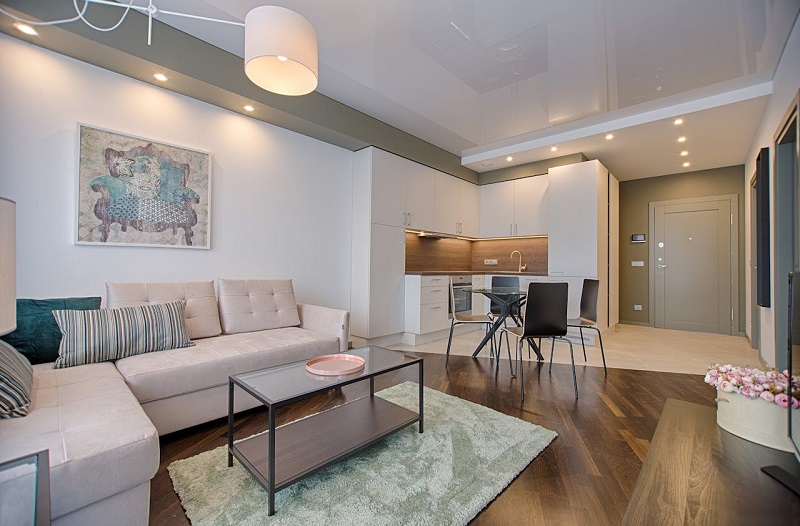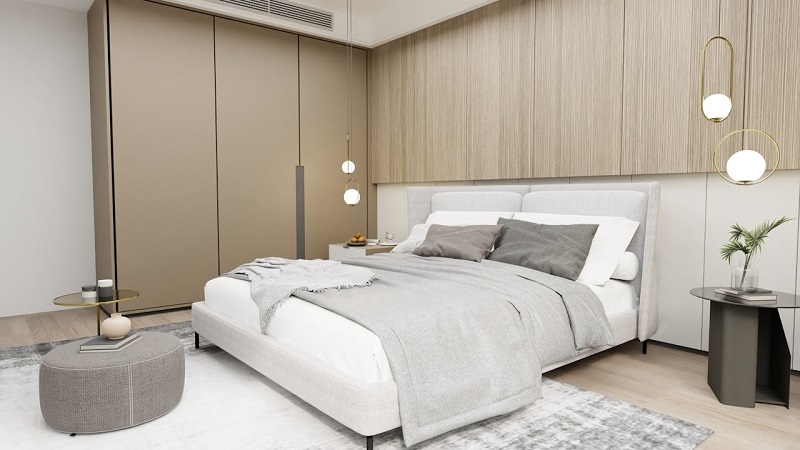Have you ever walked into a room and felt instantly uplifted or relaxed?
The right décor can make all the difference, and you don’t need a big budget or extensive renovations to achieve it.
This article will guide you through simple yet effective updates that can completely rejuvenate your living spaces.
Get ready to discover affordable ideas that will enhance your home’s aesthetic and functionality, leaving you eager to show it off.
1. Add a Fresh Coat of Paint (or an Accent Wall)

Why it works
Paint changes the room’s character by shifting light and mood. Even a single accent wall or refreshed trim color can modernize a space without replacing furniture.
How to choose colors and finishes
- Start with light test patches: test swatches on several walls because light changes hues during the day.
- Finish guide: matte or flat hides imperfections; eggshell/satin is forgiving and easy to clean for living areas; semi-gloss for trim and doors to stand up to wear.
- Accent walls: pick one wall (behind the bed, sofa, or fireplace) in a deeper tone to create depth without overwhelming the room.
Practical prep & presentation tips
- Prep surfaces: clean walls, fill holes, and sand rough spots for a clean finish.
- Use painter’s tape for sharp trim lines and quality rollers for an even coat.
- If renting, neutral colors often protect deposit return while still brightening the space.
Styling tip: Pair a neutral paint with one or two accent colors pulled from pillows or art to create a cohesive palette.
2. Update Throw Pillows and Blankets
Why textiles transform a room
Textiles are an instant mood switch—texture, pattern, and color are easy to swap and give sofas, chairs, and beds a refreshed look with minimal cost.
How to arrange and mix patterns
- Start with a base color: pick one neutral and add two accent colors.
- Mix scales: combine a large-pattern pillow, a medium pattern, and a small-scale or solid pillow for a balanced look.
- Odd numbers rule: group pillows in odd numbers (3 or 5) for a natural arrangement.
- Texture matters: add velvet, knit, linen, or faux-fur to create depth even with a muted color palette.
Stuffing & longevity
Use quality inserts (down or a high-loft synthetic) to keep pillows plump; foam or microfiber throws can make blankets both cozy and durable.
3. Rearrange or Swap Furniture
Why layout changes feel huge
Moving a piece of furniture or swapping function between rooms can open pathways, improve flow, and yield a whole new vibe without buying anything new.
Practical steps for rearranging
- Identify the focal point: orient seating to a focal point (window, fireplace, TV, or favorite artwork).
- Create conversation zones: arrange seating to face each other rather than all facing the TV; use a rug to anchor the group.
- Leave clear paths: keep walkways unobstructed and consider door swing and traffic flow.
- Scale matters: avoid oversized pieces in small rooms; smaller, multi-use furniture (nesting tables, lightweight chairs) increases flexibility.
Quick swaps that make a difference
- Turn an armchair into a reading nook by adding a floor lamp and small side table.
- Float the sofa away from the wall to create balance and allow a console behind it.
- Use inexpensively painted or swapped furniture to refresh a room’s style—replace bulky coffee table with a slim bench or ottoman for more openness.
4. Incorporate Statement Lighting

Why lighting changes mood instantly
Lighting defines ambiance—switching a single fixture, layering light, or adding a dimmer reshapes a room’s personality and functionality.
Layering light: ambient, task, accent
- Ambient: overhead lighting (chandelier, recessed lights) provides general illumination.
- Task: targeted lighting for reading, cooking, or working (table lamps, under-cabinet lights).
- Accent: highlight art or architecture with wall washers or picture lights.
Practical tips & bulb guidance
- Use dimmers to control mood and increase fixture versatility.
- Color temperature: choose warmer bulbs (about 2700–3000K) for living rooms and bedrooms; 3000–3500K for kitchens and work areas.
- For pendant lights over tables, aim for a hanging height roughly in the 30–36 inch range above the tabletop for balanced sightlines.
Upgrade idea: swap an ordinary ceiling fixture for a sculptural pendant or chandelier to create instant personality without changing other elements.
5. Hang New Wall Art or Mirrors
Why wall finishes matter
Wall art and mirrors establish focal points and introduce scale, color, and personality. Mirrors, in particular, bounce light and visually enlarge a space.
Placement & scale rules
- Hanging height: aim to center artwork near eye level—around 57–60 inches from the floor to the piece’s center is a common guideline.
- Scale to furniture: art above a sofa or console should be roughly two-thirds to three-quarters the width of the furniture for pleasing proportion.
- Gallery walls: lay out paper templates on the wall or on the floor to arrange spacing before drilling; keep consistent spacing (2–4 inches) for balance.
- Mirror placement: place mirrors opposite a window or light source to reflect light and expand the room visually.
Styling tips
Combine framed art with small sculptural objects on shelves for a layered, collected look; rotate pieces seasonally for a subtle refresh.
6. Bring in Greenery
Why plants transform a room
Plants add life, color, texture, and a sense of well-being. Even a single well-placed plant lifts mood and softens corners.
Low-maintenance plant picks
- Snake plant (Sansevieria): tolerates low light and irregular watering.
- Pothos: hardy trailing plant that thrives in varied light conditions.
- ZZ plant: very forgiving and suitable for low-light rooms.
- Spider plant or succulents: good options for beginners or sunny windowsills.
Placement & pot style
- Use varying heights—floor plants, tabletop plants, and hanging planters—to create visual interest.
- Group plants in odd numbers and mix pot textures (terracotta, ceramic, woven baskets) for a natural look.
- For low-light rooms, choose faux plants with realistic textures if live plants won’t thrive.
7. Upgrade Rugs or Curtains
Why floor and window treatments matter
Rugs ground a space and define zones; curtains affect perceived height and softness. Upgrading these elements can change scale, color, and acoustics in a room.
Rug sizing & placement
- In living rooms, either place all furniture legs on a larger rug or put front legs on the rug—both create cohesion. Common living room rug sizes are 8×10 or 9×12 for larger layouts; smaller rooms often use 5×8.
- In dining areas, ensure the rug extends beyond the table so chairs remain on the rug when pulled out—roughly 24 inches beyond the table edge is a helpful rule of thumb.
- Choose materials based on use: natural fibers (wool, jute) for durability and texture; low-pile synthetics for high-traffic rooms and easy cleaning.
Curtain length & hanging tips
- Hang curtain rods higher than the window frame (closer to the ceiling) to create the illusion of taller windows and higher ceilings.
- Extend the rod beyond the window width so curtains can be fully drawn without covering glass—this maximizes natural light.
- Choose floor-length curtains for a polished look: they should either just graze the floor or puddle slightly, depending on the style.
How to Prioritize These Updates (Quick Checklist)
- Assess impact vs. effort: are you aiming for a major visible change (paint, lighting) or a subtle refresh (pillows, plants)?
- Start with the focal point: identify which change will best highlight the room’s purpose (e.g., lighting for a reading nook).
- Layer the updates: textiles and accessories first, then larger investments like rugs or paint if needed.
- Stick to a simple palette: limit new additions to 1–2 new accent colors for cohesion.
- Document before-and-after photos: helpful for content creators and gives a clear view of the transformation success.
Common Mistakes to Avoid
- Overfilling a room with too many large pieces—leave breathing space.
- Choosing art or rugs that are too small for the furniture they’re paired with.
- Ignoring the room’s natural light when selecting paint or textile colors.
- Mixing too many competing color accents—aim for harmony, not chaos.
Conclusion
Transforming a room doesn’t require a full renovation—small, strategic décor updates can produce striking results quickly.
A fresh wall color or accent wall sets a new tone; swapping pillows and blankets refreshes texture and color; rearranging furniture improves flow and function; upgraded lighting adds both drama and practicality; thoughtfully hung art and mirrors create focal points and boost perceived space; plants bring life and softness; and properly sized rugs and curtains tie the whole look together.
Prioritize changes that deliver the most visible impact for your budget and lifestyle, and layer updates rather than attempting everything at once.
For content creators and freelance writers, each of these seven updates provides rich opportunities for “before and after” photos, budget breakdowns, and product roundups that readers love.
Use clear sizing guidelines, simple styling rules, and practical “do this, not that” advice to help readers recreate the look without guesswork.
With a few focused swaps and attention to scale, texture, and light, any room can feel refreshed and intentional—no demolition required.
Frequently Asked Questions
- Q1: Which décor update gives the biggest impact for the least money?
- A1: Swapping textiles—throw pillows, blankets, and rugs—often delivers the biggest visible change for a modest investment. These items change color, texture, and warmth without large purchases.
- Q2: Can paint make a small room look larger?
- A2: Yes. Lighter, cooler paint colors reflect more light and can open up a room visually. Painting trim in a slightly lighter tone or adding an accent wall behind focal furniture also creates depth.
- Q3: How do I choose the right rug size for my living room?
- A3: Two common approaches work well: use a large rug that fits all furniture legs or place a smaller rug under the front legs of sofas and chairs. Measure so the rug reaches at least under the front legs and visually anchors the seating area.
- Q4: What lighting changes make a room feel cozier?
- A4: Layered lighting with dimmers, warm-color bulbs (around 2700–3000K), and added task or accent lamps creates a cozier, flexible atmosphere than relying solely on overhead lighting.
- Q5: Are faux plants a good alternative to real ones?
- A5: High-quality faux plants are a practical option for low-light rooms or busy people. Choose realistic textures and mix faux with real plants where possible to maintain a natural feel.
Other Blog Posts
- 7 Creative Birthday Gift Ideas That Will Make Anyone Smile
- 7 Gift Ideas That Never Go Out of Style
- 5 Reasons Thoughtful Gifts Are Always Remembered
